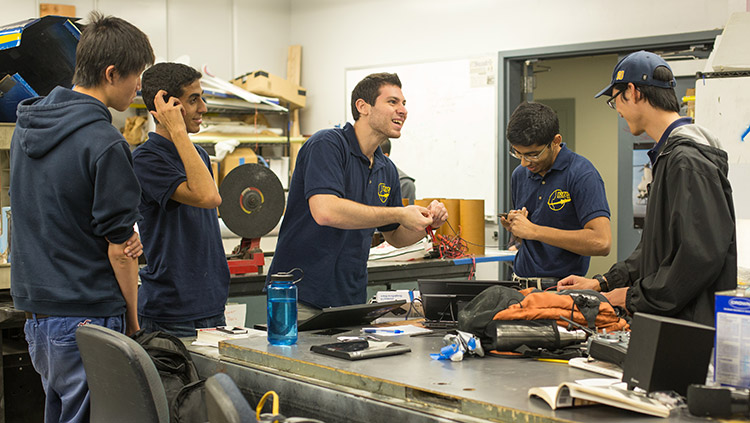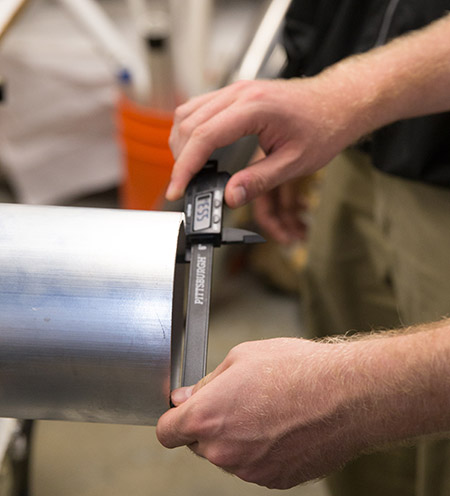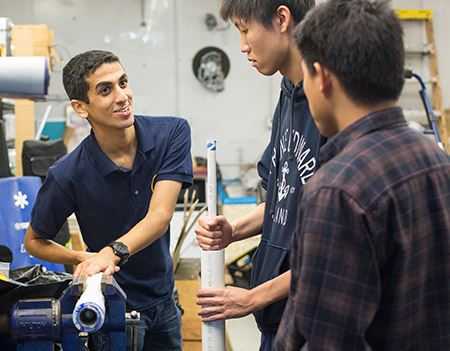
By:
- Ioana Patringenaru
Published Date
By:
- Ioana Patringenaru
Share This:

Triton Rocket Club in Furious Race to Make Campus First University to Launch Rocket into Space
Organizers hope training also will help propel students into careers
It’s Wednesday afternoon, and about a dozen students are hard at work trying to make history in the basement of Jacobs Hall. The students are building a 20-foot, two-stage rocket that they hope will make UC San Diego the first higher education institution to successfully send a rocket into space.

They are in an unofficial race against Boston University and the University of Southern California. Both campuses are pursuing the same goal and have launches planned this coming spring or summer. The Triton Rocket Club at UC San Diego is hoping to beat them to the finish line by launching in March.
Nico Montoya, a senior and mechanical engineering major, oversees the project. He has wanted to build a rocket to go to space since his freshman year, he said. “As engineers, we like to solve the next big problem,” he explained.
He also hopes that the Triton Rocket Club will be a launching pad for students looking for internships--and, later, a job. “You often need experience to get your first internship and you always need experience to get a job,” Montoya said. “The Triton Rocket Club is the place where you can get that experience.”
The $8,000 project wouldn’t be possible without the club sponsors, including the Jacobs School of Engineering, Northrop Grumman, Lockheed Martin, SPAWAR, ATA Engineering and the California Space Grant Consortium, Montoya said.
Testing and launching
Before they launch their rocket in Nevada, the Triton Rocket Club plans to test its engine in the Mojave Desert sometime within the first few weeks of the winter quarter. The engine will be tied securely to a testing rig, in what is called a static fire test. At the same time, the team’s newcomers, mostly freshmen, will get to launch a smaller solid fuel rocket they are building under Montoya’s guidance. “We’re only a few weeks in their first quarter and they already built a rocket motor,” he said. Then it’s off to Nevada, where the team will launch their 20-foot-rocket, sometime in March at the Black Rock firing range.
Rocket science is always popular with engineering students, so UC San Diego has already been home to some firsts. In October of last year, another group, Students for the Exploration and Development of Space, was the first university student group to design, manufacture and test a 3D-printed rocket engine.
Back in the basement at Jacobs Hall, also known as EBU 1, members of the Triton Rocket Club split into several teams. Some huddled around two laptops. A few more, mostly freshmen, gathered around a rocket motor they’re set to launch early next year. Jared Shapiro, an aerospace engineering senior, was sketching a design with green marker on a white board.
Team work

Shapiro leads a team that is manufacturing the rocket’s motor, fuel and nozzle. He is a transfer student from Los Angeles who builds and launches rockets as a hobby. He has spent many hours doing research to figure out the best design for the motor. Later this year, he will be machining parts out of aluminum, graphite and plastic. “My job is to make this work,” he said. “I’m very nervous and very stressed. There are a lot of emotions.”
Another team, led by aerospace students Narek Geghamyan and Aditya Zadgaonkar, is making sure that all the sensors and devices that will be on board the rocket, such as a GPS, video cameras and a device measuring speed, called an accelerometer, are working and can talk to ground-based computers during the flight and launch. They’re also in charge of making sure that the rocket’s second stage ignites when it’s supposed to. “A lot of classes are theory-based,” said Geghamyan, a senior from Los Angeles. “Here, we learn how to program and how to troubleshoot.” He has enjoyed passing down to younger students some of the knowledge he acquired as part of the club, he said.
A third team, co-led by chemical engineering major Howard Wang, built a balloon capable of flying up to 100,000 feet, which is used to test all the electronics that will be on board the rocket. That team also will be in charge of building the rocket’s launching rig out of welded steel. “Here, we can do something tangible that we can see and feel. It’s a very powerful feeling,” said Wang, a senior from the San Francisco Bay Area who has always been fascinated by space in general and astronomy in particular. Rocketry seemed like a logical extension of these interests, he said.
A fourth team, led by Nathan Woodward, is designing and manufacturing the rocket’s body.
“It really is rocket science,” Montoya pointed out.
Share This:
You May Also Like
Stay in the Know
Keep up with all the latest from UC San Diego. Subscribe to the newsletter today.


